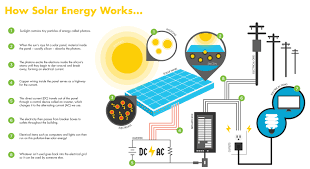People are wiser these days, which is why the clamor for alternative power sources is reverberating in all four corners of the world. Some of the best solar companies are giving suppliers of traditional energy a run for their money since more and more people are entertaining the idea of using solar energy in their homes and businesses.

In solar power generation, the sun is used as a direct source of energy, converting this energy into electricity. Nowadays, people resort to use of solar power to reduce electricity bills and to contribute to greening the environment. The buyer of Austin solar panels needs to know the basic things of how a solar power works before having a solar power system installed:
A solar panel is a collection of solar cells, connected together to increase capacity to generate a lot of electricity. Sunlight is converted by the solar panel into direct current (DC) electricity. Because of their capability to convert sunlight into electricity, solar panels are also called photovoltaic (PV) panels because the process of extracting electricity from light is called Photovoltaic. The PV cell is a PV detector which converts radiant flux into electrical current. Solar Panels are designed so that the cells face towards the sun to get most of the light available. The more light there is, the greater the amount of electricity the panels can supply.
The most widely used batteries in renewable energy and grid-backup system are the deep-cycle battery and the deep-cycle flooded lead acid battery. Several factors need to be considered when purchasing batteries such as price and capacity to store energy. It's also important to make sure the bank voltage matches system requirements. Still, the most critical factor is the cycle life of the battery which is the measurement of the number of cycles (discharge and charge) the battery provides until it reaches a certain percentage of rated capacity.
This machine measures the output of the solar solution and how to optimize the solar power system to reduce electricity usage and average power bill. It calculates units to determine how solar power works for the creation of the alternative energy units in kilowatt hours.
This brings the DC electricity to the battery, regulating the current from the solar panels, preventing overcharging of and thus, damage, to the batteries. At night when the sun is out, the solar regulator prevents the battery from back feeding into the solar panels. Different geographical locations vary in the quantities of average peak sun hours each day, affecting the amount of power the solar panels produce in 1 peak sun hour. These solar panels have rated power outputs in watts. They are either wired in series to increase voltage or in parallel to increase current. Operating temperature also affects solar panel output so that upon increase in temperature, there is a corresponding decrease in the output.
This is the network of electricity generation, transmission, distribution, and control. It links local electricity to homes. Generally, homes and businesses stay linked to the electricity grid so they remain connected with a power source, which will provide electricity at night. However, when a line goes down, users are cut off electricity. However, power can be rerouted from another line while the damaged one is repaired.
Together with the sun, these parts make up the system, which makes a solar power works to provide electricity to homes and businesses. Cost of having one installed is quite large upfront. Payback period will vary based on system, location, and energy costs.
